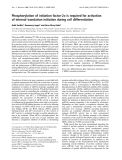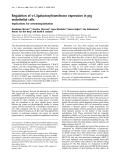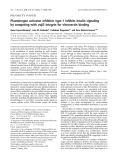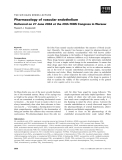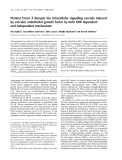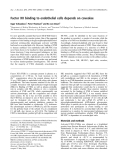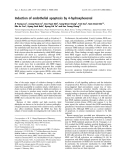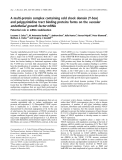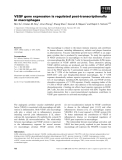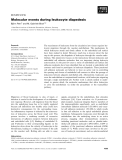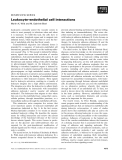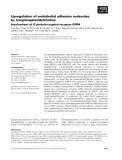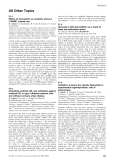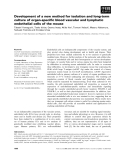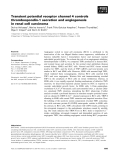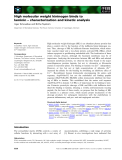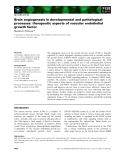
Vascular endothelial
-
The long uORF-burdened 5¢UTRs of many genes encoding regulatory proteins involved in cell growth and differentiation contain internal ribosomal entry site (IRES) elements. In a previous study we showed that utilization of the weak IRES of platelet-derived growth factor (PDGF2) is activated during megakaryocytic differentiation.
 10p
10p  system191
system191
 01-06-2013
01-06-2013
 36
36
 4
4
 Download
Download
-
The disaccharide galactosea1,3galactose (theaGal epitope) is the major xenoantigen responsible for the hyperacute vascular rejection occurring in pig-to-primates organ trans-plantation. The synthesis of theaGal epitope is catalyzed by the enzyme a1,3-galactosyltransferase (a1,3GalT). To be able to control porcinea1,3GalT gene expression speci®c-ally, we have analyzed the upstreamportionof thea1,3GalT gene, and identi®ed the regulatory sequences.
 10p
10p  research12
research12
 29-04-2013
29-04-2013
 38
38
 3
3
 Download
Download
-
Functional cooperationbetween integrins andgrowth factor receptors has been reported for several systems, oneofwhich is the modulation of insulin signaling by avb3 integrin. Plasminogen activator inhibitor type-1 (PAI-1), competes withavb3 integrin for vitronectin (VN) binding. Here we report that PAI-1, in a VN-dependent manner, prevents the cooperation of avb3 integrin with insulin signaling in NIH3T3 fibroblasts, resulting in a decrease in insulin-induced protein kinase B (PKB) phosphorylation, vascular endothelial growth factor (VEGF) expression and cell migration. ...
 8p
8p  tumor12
tumor12
 20-04-2013
20-04-2013
 38
38
 3
3
 Download
Download
-
Sir John Vane named vascular endothelium ‘the maestro of blood circula-tion’. Recently, ‘the maestro’ has become a target for pharmacotherapy of atherothrombotic and diabetic vasculopathies with well known cardio-vascular drugs belonging to the families of Angiotensin Converting Enzyme inhibitors, HMG CoA reductase inhibitors or b1 -Adrenoceptor antagonists. These drugs became upgraded to a position of the pleiotropic endothelial drugs.
 12p
12p  fptmusic
fptmusic
 11-04-2013
11-04-2013
 41
41
 3
3
 Download
Download
-
The mechanism by which the CXC chemokine platelet fac-tor 4 (PF-4) inhibits endothelial cell proliferation is unclear. The heparin-binding domains of PF-4 have been reported to prevent vascular endothelial growth factor 165 (VEGF165 ) andfibroblast growth factor 2 (FGF2) frominteractingwith their receptors. However, other studies have suggested that PF-4 acts via heparin-binding independent interactions. Here, we compared the effects of PF-4 on the signalling events involved in the proliferation induced by VEGF165 , which binds heparin, and by VEGF121 , which does not....
 0p
0p  awards
awards
 05-04-2013
05-04-2013
 39
39
 4
4
 Download
Download
-
It is now generally accepted that factor XII (FXII) binds to cellular surfaces in the vascular system. One of the suggested receptors of this binding is the glycosylphosphatidylinositol-anchored urokinase-like plasminogen activator (u-PAR) harbored in caveolae/lipid rafts. However, binding of FXII to human umbilical vein endothelial cells (HUVEC) has never been shown to be localized to these specialized mem-brane structures. Using microscopical techniques, we here report that FXII binds to specific patches of the HUVEC plasma membrane with a high density of caveolae....
 8p
8p  awards
awards
 05-04-2013
05-04-2013
 45
45
 6
6
 Download
Download
-
Lipid peroxidation and its products such as 4-hydroxy-2-nonenal (HNE) and 4-hydroxyhexenal (HHE) are known to affect redox balance duringagingand various degenerative processes, includingvascular dysfunction. Deterioration of the endothelial cells that line the vascular wall is known to be an underlyingcause of vascular dysfunction. At present, little is known about themechanismbywhichHHE induces endothelial cell death (i.e. apoptosis), although HNE-induced apoptotic cell death has been reported. ...
 9p
9p  dell39
dell39
 03-04-2013
03-04-2013
 28
28
 3
3
 Download
Download
-
Vascular endothelial growth factor (VEGF) is a key regu-lator of angiogenesis and post-transcriptional regulation plays a major role in VEGF expression. Both the 5¢-and 3¢-UTR are required for VEGF post-transcriptional regu-lation but factors binding to functional sequences within the 5¢-UTR have not been fully characterized. We report here the identification of complexes, binding to theVEGF mRNA 5¢-and3¢-UTR, that contain cold shock domain (CSD) and polypyrimidine tract binding (PTB) RNA binding proteins. ...
 13p
13p  dell39
dell39
 03-04-2013
03-04-2013
 42
42
 5
5
 Download
Download
-
The macrophage is critical to the innate immune response and contributes to human diseases, including inflammatory arthritis and plaque formation in atherosclerosis. Vascular endothelial growth factor (VEGF) is an angio-genic cytokine that is produced by macrophages.
 14p
14p  dell39
dell39
 27-03-2013
27-03-2013
 41
41
 4
4
 Download
Download
-
The recruitment of leukocytes from the circulation into tissues requires leu-kocyte migration through the vascular endothelium. The mechanisms by which leukocytes attach and firmly adhere to the endothelial cell surface have been studied in detail. However, much less is known about the last step in this process, the diapedesis of leukocytes through the vascular endo-thelium.
 9p
9p  inspiron33
inspiron33
 25-03-2013
25-03-2013
 42
42
 5
5
 Download
Download
-
Leukocytes constantly patrol the vascular system in order to react promptly to infections when and where it is necessary. To fulfil this task, the cells have to enter secondary lymphoid organs and to emigrate into inflamed tissues, which requires them to cross the bar-rier of endothelial cells that line blood vessels.
 2p
2p  inspiron33
inspiron33
 25-03-2013
25-03-2013
 53
53
 4
4
 Download
Download
-
Lysophosphatidylcholine induces expression of adhesion molecules; how-ever, the underlying molecular mechanisms of this are not well elucidated. In this study, the intracellular signaling by which lysophosphatidylcholine upregulates vascular cell adhesion molecule-1 and P-selectin was delineated using YPEN-1 and HEK293T cells.
 12p
12p  galaxyss3
galaxyss3
 21-03-2013
21-03-2013
 35
35
 3
3
 Download
Download
-
Current evidence suggests that the beneficial effects of statins seem to be mediated not only by their lipid-lowering properties but also by improving vascular endothelial cell function. Chronic inhibition of endothelial nitric oxide synthesis by oral administration of Nw-nitro-L-arginine methyl ester (L-NAME) to rats induces early vascular inflammation and subsequent arteriosclerosis.
 42p
42p  galaxyss3
galaxyss3
 19-03-2013
19-03-2013
 42
42
 4
4
 Download
Download
-
The uptake of five fluorescein labeled cell-penetrating peptides (Tat, Tat2, mutated-Tat, peptide vascular endothelial-cadherin and transportan) was studied in wheat immature embryos. Interestingly, permeabilization treat-ment of the embryos with toluene⁄ethanol (1 : 20, v⁄v with permeabiliza-tion buffer) resulted in a remarkably higher uptake of cell-penetrating peptides, whereas nonpermeabilized embryos failed to show significant cell-penetrating peptide uptake, as observed under fluorescence microscope and by fluorimetric analysis....
 12p
12p  media19
media19
 06-03-2013
06-03-2013
 50
50
 3
3
 Download
Download
-
Endothelial cells are indispensable components of the vascular system, and play pivotal roles during development and in health and disease. Their properties have been studied extensively byin vivo analysis of genetically modified mice.
 11p
11p  media19
media19
 06-03-2013
06-03-2013
 57
57
 3
3
 Download
Download
-
Vascular endothelial growth factor (VEGF) family members play impor-tant roles in embryonic development and angiogenesis during wound healing and in pathological conditions such as tumor formation. Parapox-viruses express a new member of the VEGF family which is a functional mitogen that specifically activates VEGF receptor (VEGFR)-2 but not VEGFR-1.
 11p
11p  media19
media19
 05-03-2013
05-03-2013
 30
30
 3
3
 Download
Download
-
Angiogenic switch in renal cell carcinoma (RCC) is attributed to the inactivation of the von Hippel–Lindau tumor suppressor, stabilization of hypoxia inducible factor-1 transcription factor and increased vascular endothelial growth factor.
 13p
13p  media19
media19
 05-03-2013
05-03-2013
 29
29
 2
2
 Download
Download
-
High molecular weight kininogen (HK) is an abundant plasma protein that plays a central role for the function of the kallikrein⁄kinin⁄kininogen sys-tem. Thus, cleavage of HK by kallikrein liberates bradykinin, which stimu-lates vascular repair and a two-chain protein, activated HK (HKa), which induces apoptosis in proliferating endothelial cells.
 11p
11p  vinaphone15
vinaphone15
 25-02-2013
25-02-2013
 39
39
 1
1
 Download
Download
-
The angiogenic process in the central nervous system (CNS) is basically regulated by typical angiogenic signaling systems such as vascular endothe-lial growth factor (VEGF)–VEGF receptors and angiopoietin–Tie recep-tors. In addition to regular endothelial–pericyte interaction, the CNS vasculature has a unique system of cell to cell communication between endothelial cells and astrocytes which is known as the blood–brain barrier.
 8p
8p  vinaphone15
vinaphone15
 25-02-2013
25-02-2013
 37
37
 3
3
 Download
Download
-
The vascular endothelium is exposed to an array of physical forces, includ-ing shear stress via blood flow, contact with other cells such as neighboring endothelial cells and leukocytes, and contact with the basement membrane. Endothelial cell morphology, protein expression, stiffness and cytoskeletal arrangement are all influenced by these mechanochemical forces.
 14p
14p  mobifone23
mobifone23
 18-01-2013
18-01-2013
 45
45
 3
3
 Download
Download
CHỦ ĐỀ BẠN MUỐN TÌM









